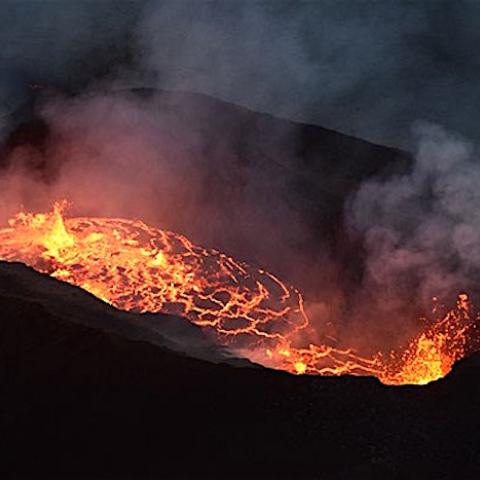Though not explosively dangerous like Mount St. Helens or Krakatoa, the Kīlauea volcano at Hawai'i Volcanoes National Park is a potent cauldron of earth energy in the form of molten magma. The following photos and video taken late last week hint at the volcano's power.

A view of Pu‘u ‘Ō‘ō's cone at Hawai'i Volcanoes National Park/USGS

The collapsed crater in Pu‘u ‘Ō‘ō. This photo looks to the east, and shows the deep collapse crater formed on Monday, April 30, when magma beneath Pu‘u ‘Ō‘ō drained. For scale, the crater is about 250 meters (820 feet) wide/U.S. Geological Survey

New lava fissure on Makamae and Leilani Streets in Leilani Estates subdivision photographed early May 4/U.S. Geological Survey

The opening phases of fissure eruptions are dynamic. Additional vents and new lava outbreaks may occur. The fissure in Leilani Estates (as of 6:00 p.m.) was about 150 m (164 yards) long/U.S. Geological Survey

Fissure No. 3 at Leilani and Kaupili streets on May 4, 2018/U.S. Geological Survey

This plume arose from Kilauea after a 6.9 magnitude earthquake Friday/U.S. Geological Society

This map depicts the location of the Middle and Lower East Rift Zones at Hawai'i Volcanoes National Park/U.S. Geological Survey

At 7:45 a.m. local time Saturday, Fissure 8 slow advanced to the northeast on Hookapu Street in Leilani Estates subdivision on Kīlauea Volcano's lower East Rift Zone/USGS




 Support Essential Coverage of Essential Places
Support Essential Coverage of Essential Places







Comments
Wow! The photos and video are really dramatic. The photo that amazes me the most, though, is the second one: the collapsed floor in the crater of Pu‘u ‘Ō‘ō. In 2017, I and a group of other photo tour attendees took an open-door helicopter ride over this very crater, when the crater floor was still present. Big difference!